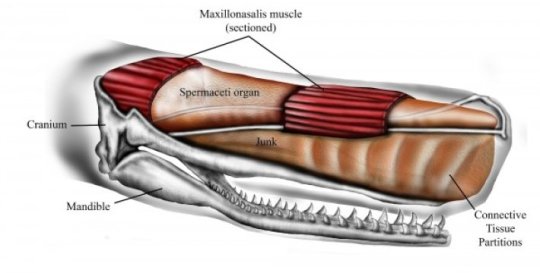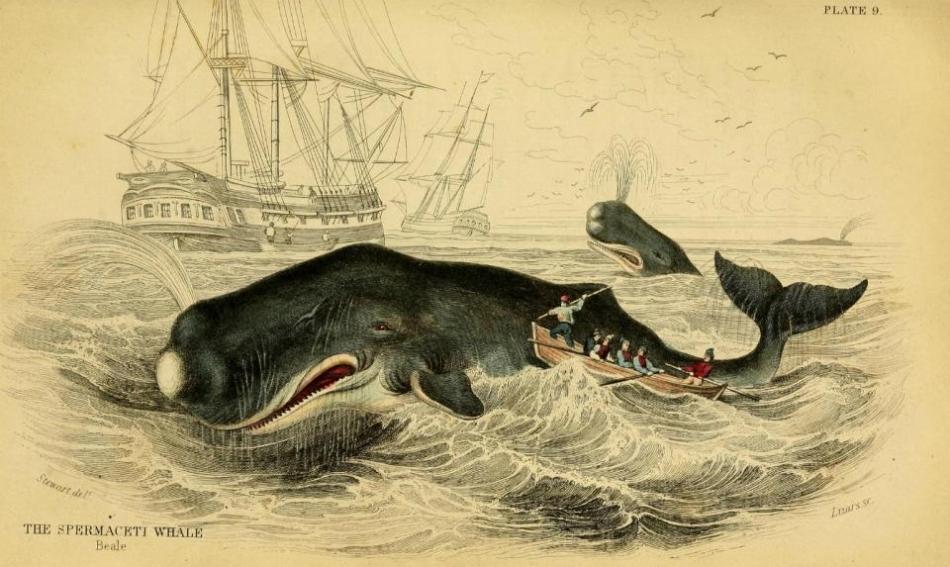April 10 - 23 2016: Issue 259
Moby Dick is True: Scientists Unravel the 'Mystery'- School Holidays 2016
Architecture of the sperm whale forehead facilitates ramming combat
April 5, 2016

Diagram of the sperm whale head structure. Credit: Ali Nabavizadeh
A new study addresses a controversial hypothesis regarding the potential ramming function of the sperm whale's head. The hypothesis, originally proposed by a 19th century whaler, suggests that the forehead of male sperm whales evolved partly to be used as a battering ram weapon when fighting for access to reproductively active females. This hypothesis was instrumental in inspiring Herman Melville to write the novel Moby Dick but its mechanical feasibility had never been addressed.
An interdisciplinary team from Australia, UK, USA and Japan used structural engineering principles to test how the head of the sperm whale might be able to resist strong ramming impacts.
"The sperm whale forehead is one of the strangest structures in the animal kingdom," says Dr. Olga Panagiotopoulou from the University of Queensland, and the lead author of the paper. "Internally the forehead is composed of two large oil-filled sacs, stacked one on top of the other, known as the spermaceti organ and the junk sacs. It is the oil within the upper spermaceti organ that was the main target of the whaling industry in the early 19th century." Panagiotopoulou adds, "This whole complex is highly sexually dimorphic which means that it is much larger in males than in females, a pattern commonly found in species in which males fight to compete for females."
The battering ram hypothesis was originally proposed by a 19th whaler, Owen Chase, after his ship, the Essex, was sunk by a large male that intentionally rammed the ship with his forehead.
Professor David Carrier, a co-author from the University of Utah said "we know that the sperm whale head is important in transmitting sonar clicks and there are many other hypotheses about its role in communication and buoyancy." "But none of these hypotheses could explain how the sperm whale head could function as a weapon capable of sinking ships that are four to five times the mass of the whale."
"The ramming hypothesis was received with reluctance by the scientific community" says Panagiotopoulou. "This was mainly because the front part of the sperm whale head houses sensitive anatomical structures that produce the sounds essential for sonar and would be in harm's way in a ramming event. Also not many people had actually observed sperm whales ramming."
"We were fascinated when we received a report from a pilot and conservation researcher, who documented sperm whales ramming while flying over the Gulf of California" says Carrier. And adds "we then knew that our ramming hypothesis had some merit and looked into the available technology to test it."
"Creating a computer model to simulate ramming in sperm whales was a challenging task" adds Dr. Spyridis, consulting engineer and a co-author of the study. "When analysing bridges, tunnels, or buildings you are given exact measurements and material properties for the simulations but in this case we were restricted to limited published data and we had to perform a series of sensitivity tests to ensure model efficiency," he adds.
"We used probabilistic simulation to study the mechanical effects of impact variation," said Associate Professor Todd Pataky from Shinshu University in Japan and senior author of the paper. "After creating a series of modified versions of the type and direction of impact force on the sperm whale head, we concluded that the connective tissue partitions embedded within the junk absorb impact stresses and protect the skull from fracturing"
"Increased skull stresses at a ramming event can be detrimental for the animal since they can cause fatal fractures," says Panagiotopoulou. "Our findings show that the mechanical advantage of the structure of the junk may be the result of acquired traits related to selection on male to male aggressive behaviour. Although male sperm whales may not fight frequently, we know that aggressive ramming behaviour is a common characteristic in the group of mammals from which whales are derived -- the even-toed ungulates, the artiodactyls. A closer look into the anatomy of the heads of other species of whales that ram may reveal a variety of protective mechanisms."
"Our study has limitations but we hope to stimulate future research to unravel the mechanical function of the head during head-butting events in other species, where aggressive behaviour has been observed, but remains unmodelled" added Panagiotopoulou.
Olga Panagiotopoulou, Panagiotis Spyridis, Hyab Mehari Abraha, David R. Carrier, Todd C. Pataky. Architecture of the sperm whale forehead facilitates ramming combat. PeerJ, 2016; 4: e1895 DOI: 10.7717/peerj.1895

19th Century whalers pursued sperm whales for their oil - although these sometimes fought back. Etching credit - Biodiversity Heritage Library.
Moby Dick; or, The white whale
Moby-Dick; or, The Whale (1851) is a novel by Herman Melville considered an outstanding work of Romanticism and the American Renaissance. Ishmael narrates the monomaniacal quest of Ahab, captain of the whaler Pequod, for revenge on Moby Dick, a white whale which on a previous voyage destroyed Ahab's ship and severed his leg at the knee. Although the novel was a commercial failure and out of print at the time of the author's death in 1891, its reputation as a Great American Novel grew during the twentieth century. William Faulkner confessed he wished he had written it himself, and D. H. Lawrence called it "one of the strangest and most wonderful books in the world", and "the greatest book of the sea ever written". "Call me Ishmael" is one of world literature's most famous opening sentences. The product of a year and a half of writing, the book is dedicated to Nathaniel Hawthorne, "in token of my admiration for his genius", and draws on Melville's experience at sea, on his reading in whaling literature, and on literary inspirations such as Shakespeare and the Bible. The detailed and realistic descriptions of whale hunting and of extracting whale oil, as well as life aboard ship among a culturally diverse crew, are mixed with exploration of class and social status, good and evil, and the existence of God. In addition to narrative prose, Melville uses styles and literary devices ranging from songs, poetry and catalogs to Shakespearean stage directions, soliloquies and asides.
There were slight but important differences between the texts of the London edition, which appeared first, and the New York edition. The London publisher cut or changed sensitive passages and Melville made changes as well, including a last-minute change in the title. The work first appeared as The Whale in London in October 1851 and then under its definitive title Moby-Dick in New York in November. The whale, however, appears in both the London and New York editions as "Moby Dick", with no hyphen. The British edition was not reprinted, while the American edition was reprinted three times, the last time in 1871. Only 3,200 copies were sold during the author's life.
Moby Dick (1956 film)
Set in 19th-century New England, the story follows the whaling ship Pequod and its crew. Leading them is Captain Ahab, who was almost killed in an encounter with the "great white whale", Moby Dick. Now he is out for revenge. With the crew that has joined him, Ahab is out to destroy the huge sea mammal, but his obsession with vengeance is so great that he cannot turn back, eventually leading to the death of Ahab and all of his crew, save his newest able seaman, Ishmael.
Cast
Gregory Peck as Captain Ahab
Richard Basehart as Ishmael
Leo Genn as Starbuck
James Robertson Justice as Captain Boomer
Harry Andrews as Stubb
Bernard Miles as The Manxman
Noel Purcell as Ship's Carpenter
Edric Connor as Daggoo
Mervyn Johns as Peleg
Joseph Tomelty as Peter Coffin
Francis de Wolff as Captain Gardiner
Philip Stainton as Bildad
Royal Dano as Elijah
Seamus Kelly as Flask
Friedrich von Ledebur as Queequeg
Orson Welles as Father Mapple
Tamba Allenby as Pip (uncredited)
Tom Clegg as Tashtego (uncredited)
Ted Howard as Perth (uncredited)
Iris Tree as Bible woman (uncredited)
John Huston as the voice of Peter Coffin and a Pequod lookout (uncredited)
Peck was initially surprised to be cast as Ahab (part of the studio's agreement to fund the film was that Huston use a "name" actor as Ahab). Peck later commented that he felt Huston himself should have played Ahab. Ironically, Huston had originally intended to cast his own father, the actor Walter Huston in the role, but his father had died by the time the film was made. Peck went on to play the role of Father Mapple in the 1998 television miniseries adaptation of Melville's novel, with Patrick Stewart as Ahab.
Welles later used the salary from his cameo to fund his own stage production of Moby Dick, in which Rod Steiger played Captain Ahab.
The Pequod was portrayed by, appropriately, the Moby Dick. Built in England in 1887 as the Ryelands, the ship came into the hands of the film industry in the 50s, and was also used in Treasure Island. It was destroyed by fire in Morecambe, England in 1972.
The schooners used were Harvest King and James Postlethwaite, both from Arklow, Ireland.
Gregory Peck, comparing his performances in this film and the 1998 Moby Dick miniseries, said he liked the miniseries better because it was more faithful to the novel.
The film began shooting in Wales at Huston's request.[6] Parts of the movie were shot at the sea in front of Caniçal, a traditional whaling parish in Madeira Islands, Portugal, with real action of whaling, done by whalers of Madeira Island. It was also filmed in Las Canteras beach, Las Palmas de Gran Canaria, Canary Islands, Spain. Captain Alan Villiers commanded the ship for the film.
Many exterior scenes set in New Bedford were shot on location in Youghal, Co. Cork, Ireland. The town has a public house, originally called Linehan's and at that time owned by Paddy Linehan, whose exterior appears in the movie. It was renamed Moby Dick's shortly after filming by Mr. Linehan. It is still owned and run by the Linehan family and boasts a fine collection of photographs taken of the cast and crew during the making of the film. While there, John Huston used the bar as his headquarters to plan each day's filming. The town's harbor basin, in front of Moby Dick's bar, was used to stand in as New Bedford's harbor, and some local people appear as extras in the ship's departure scene. Youghal's nineteenth century lighthouse also appears in a scene of the Pequod putting to sea (at sunset) on her fateful voyage.[8][9]
Of the three film versions of Moby Dick made between 1926 and 1956, Huston's is the only one which is faithful to the novel and uses its original ending.
In the Heart of the Sea is a 2015 American biographical survival-drama film based on Nathaniel Philbrick's 2000 non-fiction book of the same name, about the sinking of the American whaling ship Essex in 1820, an event that inspired the novel Moby-Dick. It was directed and produced by Ron Howard and written by Charles Leavitt, the film stars Chris Hemsworth, Benjamin Walker, Cillian Murphy, Tom Holland, Ben Whishaw, and Brendan Gleeson. It premiered in New York City on December 7, 2015 and was released in cinemas in the United States on December 11, 2015 by Warner Bros. Pictures.
Essex was an American whaler from Nantucket, Massachusetts, launched in 1799. While under the command of Captain George Pollard, Jr., in 1820 a sperm whale attacked and sank her. The sinking stranded the twenty-man crew in the southern Pacific Ocean with little food and water.
Moby Dick (1956 film). (2016, March 27). In Wikipedia, The Free Encyclopedia. Retrieved from https://en.wikipedia.org/w/index.php?title=Moby_Dick_(1956_film)&oldid=712163337